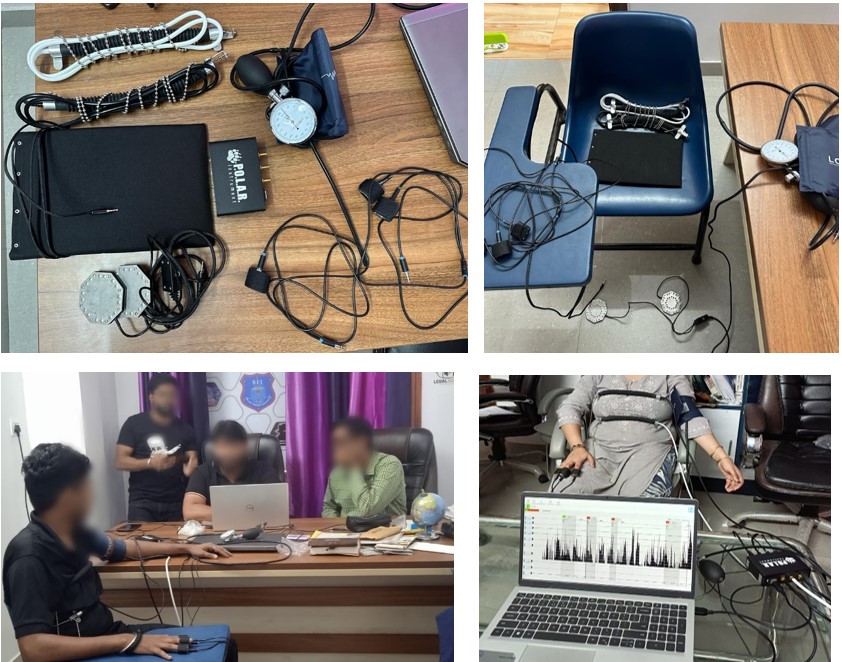
-
ceo.bfi@gmail.com
Send Email
-
2C, C-6/A Block, Janakpuri, Delhi India 110058
Visit Our Office
99902-92279
Confidentiality Guaranteed
99902-92279
Confidentiality Guaranteed

Jun
LIE DETECTOR TEST POLYGRAPH
Ever watched a crime show where someone’s strapped to a machine, sweating while a line jumps across a screen? That’s the classic image of a polygraph test—but real-life lie detection goes far beyond TV drama.
A polygraph test, or lie detector test, measures physiological responses such as breathing, heart rate, blood pressure, and skin conductivity while a person answers a structured set of questions. The idea is simple:
When people lie, their bodies react—and the polygraph records those reactions.
The polygraph isn’t magic, nor is it a mind reader. It’s a scientific investigative tool used by law enforcement agencies, government departments, private investigators, and corporate organizations.
In the United States, polygraph tests are widely used for security clearance (CIA, FBI, NSA), while still being debated in legal contexts. The Supreme Court has repeatedly ruled that polygraph results are not automatically admissible in court, though they remain influential in investigations and employment screenings.
The polygraph operates on a basic principle:
Deception causes involuntary physiological changes.
If those changes spike at specific questions, the examiner takes note.
Understanding the Polygraph Machine
Let’s break down what keeps this “truth-sniffing” device running.
1. Pneumography Tubes
Rubber tubes placed around the chest and abdomen measure breathing patterns.
Irregular breathing = possible stress response.
2. Galvanic Skin Response Sensors
Attached to the fingers, these sensors detect sweating.
More sweat = higher conductivity = possible deception.
3. Blood Pressure Cuff
Records blood pressure and pulse.
A sudden rise can indicate anxiety or dishonesty.
4. Data Recording System
All readings are displayed on a computer or paper.
The final readout is known as the polygram, which examiners analyze line by line.
A polygraph test isn’t just plugging wires and firing questions. It follows a structured method:
1. Pre-Test Phase
Explanation of the process
Establishing rapport
Asking simple control questions
This sets the baseline for physiological readings.
2. In-Test Phase
Now the real questioning begins.
Relevant questions (“Did you take the money?”) are mixed with neutral and control questions.
Examiners watch for unusual spikes in the polygram.
3. Post-Test Phase
The examiner studies the recorded data to determine whether physiological responses suggest truth or deception.
Favorable Conditions for Accurate Testing
Physical Environment
A quiet, distraction-free room with controlled temperature is essential.
Psychological Readiness
The subject must be:
Alert
Calm
Sober
Fatigue, medication, or emotional stress affect accuracy.
Decoding the Polygram: How Examiners Interpret Results
Polygraph interpretation blends science + expertise.
Physiological Indicators of Deception
Sudden heart rate spikes
Breathing irregularities
Drops in skin resistance
Role of the Examiner
Examiners don’t judge based on one spike—they look for patterns.
Experience is crucial for separating nervousness from dishonesty.
Types of Polygraph Testing Services
Polygraph tests are used in many real-world situations, not just crime dramas.
1. Criminal Investigations
Used to assess suspects, verify witness claims, or guide investigative direction.
2. Pre-Employment Screening
Common in the United States for agencies that require high integrity:
CIA, FBI, DEA, Defense and intelligence sectors
3. Infidelity & Relationship Testing
Private individuals often request polygraphs for relationship disputes.
4. Corporate Integrity Assessments
Used discreetly for internal theft, fraud, or misconduct investigations.
Who Can Avail Polygraph Testing?
Law Enforcement Agencies
During investigations or background screening.
Government & Defense Departments
Critical for national security and intelligence roles.
Private Individuals
For personal matters such as theft, relationship doubts, or disputes.
Corporate Organizations
To maintain workplace integrity and resolve sensitive cases.
Final Thoughts
The lie detector test is a unique blend of psychology, physiology, and investigative science. While not perfect, it can be an incredibly powerful tool when used correctly.
It doesn’t read minds—but it does read the body.
And often, the body reveals the truth that words try to hide.
Whether you’re verifying honesty, resolving disputes, or assisting an investigation, the polygraph test can provide valuable insight—if used professionally and ethically.
Frequently Asked Questions (FAQs)
Not always. It depends on the country and the court. Some jurisdictions allow it with consent; others reject it due to questions about reliability.
It’s possible, but difficult. People try to manipulate their responses, but trained examiners often detect such attempts.
The full session usually lasts 1.5 to 3 hours, including the pre-test and post-test phases.
Physically, no. But emotionally, it can be stressful. That’s why mental preparedness is crucial.
It varies. Private tests can range from ₹10,000 to ₹40,000 in India, depending on the examiner and locationContent
Call To Action

Are you interested in learning more about forensic expert or seeking professional forensic-expert services? Contact us today to inquire about our expertise.
📞 Contact Us: 9990292279
🌐 Visit Our Website: https://forensicexpertinvestigation.com/
✉️ Email: ceo.bfi@gmail.com





